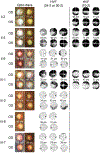Long-Term Follow-Up of Normal Tension Glaucoma Patients With TBK1 Gene Mutations in One Large Pedigree
- PMID: 31987900
- PMCID: PMC7282998
- DOI: 10.1016/j.ajo.2020.01.017
Long-Term Follow-Up of Normal Tension Glaucoma Patients With TBK1 Gene Mutations in One Large Pedigree
Abstract
Purpose: To characterize features of glaucoma associated with a TANK binding kinase 1 (TBK1) gene duplication, which is among the most common molecularly defined causes of normal tension glaucoma (NTG).
Design: Retrospective observational case series.
Methods: We conducted a retrospective case series, by reviewing medical records of 7 members of a pedigree with NTG caused by TBK1 gene duplications. Clinical features of these patients at diagnosis, throughout management, and at latest follow-up were identified, including age, intraocular pressure (IOP), central corneal thickness (CCT), optic nerve head appearance, and mean deviation (MD) assessed with Humphrey visual field (HVF) testing protocols.
Results: At initial diagnosis, the mean age was 35 ± 7 years, IOP was 16 ± 2.1 mm Hg, cup-to-disc (C/D) ratio was 0.9 ± 0.08, and MD assessed via HVF 30-2 and/or 24-2 testing protocols was -9.0 ± 8.9 (range: -1.8 to -27) dB in the 14 study eyes. At initial diagnosis, 4 of 14 eyes (28%) had no visual field defect, 4 (28%) had early visual field defects, and 6 (43%) had severe visual field defects. Patients had a mean follow-up of 21.5 ± 9.0 years and experienced an average reduction of IOP by 28%. Four of 12 eyes (33%) had stable visual fields throughout follow-up, while 8 eyes (67%) had slow-to-moderate progression. The 30-2 and/or 24-2 HVF tests had an average change in MD of -0.53 ± 0.26 dB/year. No eyes had rapid progression with an MD >1.0 dB/year. At final follow-up, the mean IOP was 11.5 ± 2.9, and C/D ratio was 0.94 ± 0.4. At final follow-up, 3 of 14 eyes (21%) had early visual field defects, 4 (29%) had moderate visual field defects, and 7 (50%) had severe visual field defects. Six of 14 eyes (43%) met criteria for legal blindness.
Conclusions: We provide the first report of the clinical features and long-term clinical course in a family of NTG patients with TBK1 gene duplications. TBK1-associated glaucoma exhibits classic features of NTG. Patients present with severe disease at a relatively early age and most (67%) have slow-to-moderate progression of their visual field defects. The rate of visual field change appears correlated with the magnitude of IOP, suggesting that it may be advantageous to set extremely low IOP targets for some patients with TBK1-associated glaucoma.
Copyright © 2020 Elsevier Inc. All rights reserved.
Figures



References
-
- Tham Y-C, Li X, Wong TY, Quigley HA, Aung T, Cheng C-Y. Global Prevalence of Glaucoma and Projections of Glaucoma Burden through 2040: A Systematic Review and Meta-Analysis. Ophthalmology 2014;121(1):2081–2090. - PubMed
-
- Collaborative Normal-Tension Glaucoma Study Group. Comparison of glaucomatous progression between untreated patients with normal-tension glaucoma and patients with therapeutically reduced intraocular pressures. Am J Ophthalmol 1998;126(4):487–497. - PubMed
Publication types
MeSH terms
Substances
Grants and funding
LinkOut - more resources
Full Text Sources
Miscellaneous

